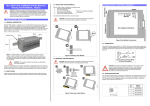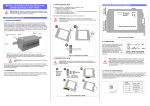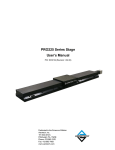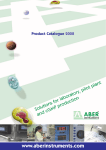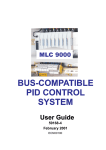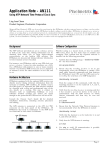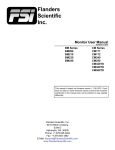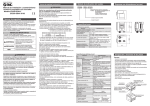Download mlc 9000+ bus communications module installation manual 59325
Transcript
To install the Bus Module follow the instructions below: 1.1 GENERAL DESCRIPTION The MLC 9000+ System - comprising one or more Bus Module each with up to eight Loop Modules - is designed for installation in an enclosure which is sealed against the ingress of dust and moisture. The enclosure must contain sufficient length of 35mm Top-Hat DIN mounting rail to accommodate the system modules (see below) plus an extra 50mm of rail to permit modules to be separated for removal/replacement. The space required by the MLC 9000+ modules is shown below. 22mm 30mm DIN Rail Clamp Power Input 18 – 30V dc 30W Max 0V 2 +24V 1 1. INSTALLATION - MECHNICAL 2. INSTALLATION – ELECTRICAL (GENERAL) The MLC 9000+ system is installed in the following order: 1. Bus Communications Module 2. Interconnect Module(s) Refer to Loop Module installation 3. First Loop Controller Module instructions 4. Second Loop Controller Module 5. Third Loop Controller Module etc….. Configuration Port CAUTION: Installation and configuration should be performed only by personnel who are technically competent to do so. Local Regulations regarding electrical installation & safety must be observed. 1.3 INSTALLING THE BUS MODULE CAUTION: Ensure that the power has been removed from all equipment currently in the enclosure before installing the Bus Module 120mm Click! Field Bus Port MLC 9000+ BUS COMMUNICATIONS MODULE INSTALLATION MANUAL 59325-1 Use Copper Conductors 100mm Figure 4 Bus Module Connections 2.1 POWER INPUT The system requires a power input of 18 - 30V DC and has a maximum power consumption of 30W. It is recommended that the power supply is connected via a two-pole isolating switch (preferably situated near the System) and a 2A slow-blow fuse or a 2A Type C MCB (see Figure 5). NOTE: An additional 60mm of space is required above and below the system modules to permit ventilation and to accommodate wiring bend radii to enclosure trunking or conduits. Allow sufficient slack in all cables inside the trunking to permit “hot” swapping of modules (i.e. modules to be removed/replaced whilst the system is under power). WARNING: The maximum of eight Loop Module’s per Bus Module must not be exceeded. It is recommended that (a) some means of preventing unauthorised access to the enclosure interior (e.g. lockable doors) is provided, and (b) that a suitable DIN rail clamp be used, once the MLC 9000+ system is fully installed, to prevent the system from moving on the DIN rail. 1 1.4 REMOVING THE BUS MODULE Unplug all connectors from the Bus Module DIN Rail Bus Module Slide Loop Modules/ Interconnect Modules clear 2A +24V Figure 5 Recommended Mode of Power Connection CAUTION: Ensure that the power has been removed from all equipment currently in the enclosure before uninstalling the Bus Module 1.2 VENTILATION Under normal circumstances, no forced ventilation is required and the enclosure need not contain ventilation slots, but temperatures within the enclosure must be within specification. 0V 2 Figure 2 Installing a Bus Module CAUTION: The system is designed for installation in an enclosure, which provides adequate protection against electric shock. Local regulations regarding electrical installation and safety should be rigidly observed. Consideration should be given to prevention of access to the power terminations by unauthorised personnel. 2.2 CONFIGURATION PORT This connects the Bus Module to a local PC for configuration. The configuration port uses the point to point connection specification RS232. Pin connections are shown on the right. This port can only be used for configuration purposes only using the MLC 9000+ configuration software. (Part number MLC 9000-AN111) Pin No. Figure 3 Removing a Bus Module 1 2 3 4 RJ11 Connector Signal / Function 1 Receive Data 2 Transmit Data 3 No connection 4 Signal Ground 3. INSTALLATION – ELECTRICAL (FIELDBUS PORT) 4. BUS MODULE SPECIFICATION 3.1 MODBUS – BM220-MB Bus Module only This connects the Bus Module to a MODBUS master device (local operator interface/display or multi-drop PC operator and configuration network). The Modbus Fieldbus port uses the multi(Red) Tx/Rx+ (A) drop connection standard RS485. Pin connections are shown on the right. The Common connection is (White) Tx/Rx– (B) provided for termination of screened (shielded) (Green) Common cable. Configuration Port: (All Bus Modules) MODBUS Port: (BM220-MB only) 3.2 CANopen/DEVICENET – BM230-CO or DN Bus Modules only Both the CANopen and DeviceNet fieldbus protocols use the same CAN hardware standard. When installed with the CANopen firmware (BM230-CO) the Bus Module can be connected to a CANopen enabled master device. CANopen compliant cables and connectors must be used when connecting to the network. When installed with the DeviceNet firmware (BM230DN) the Bus Module can be connected to a DeviceNet enabled master device. DeviceNet compliant cables and connectors must be used when connecting to the network. Both CANopen and DeviceNet networks must be terminated with 121ohm resistors V+ (Red) between CAN_L and CAN_H at each physical end of the CAN network. A CAN_H (White) separate 24V power supply should be SHIELD used to power the network between V+ CAN_L (Blue) and V-. Terminal connections are shown V- (Black) on the right. The SHIELD connection is provided for termination of screened (shielded) cable. DeviceNet Port: (BM230-DN only) PROFIBUS Port: (BM240-PB only) Note: Most DeviceNet communication problems are caused by incorrect wiring and power supply selection if any problems are encountered the DeviceNet website has guidelines on wiring a DeviceNet system. (www.odva.org) 3.3 PROFIBUS – BM240-PB Bus Module only This enables the Bus Module to be connected to a PROFIBUS-DP master device (local operator interface/display, PLC or multi-drop PC operator and configuration network). PROFIBUS compliant cables and connectors must be used when connecting to a network. Pin connections are shown on the right. For more information on PROFIBUS consult the PROFIBUS website (www.profibus.com) 9 6 Ethernet/IP Port: (BM250-EI only) 5 3 4 5 6 7 RxD/TxD+ CNTR-P DGND VP RxD/TxD- MODBUS/TCP Port: (BM250-MT) CANopen Port: (BM230-CO) 1 Supply Voltage 3.4 ETHERNET/IP & MODBUS TCP/IP – BM250-MT or EI Bus Modules only This connects the Bus Module to an Ethernet/IP or MODBUS TCP/IP enabled master device (local operator interface/display, PLC or multi-drop PC operator and configuration network). The connection is via RJ45 connector that conforms to CAT 5 cabling and 568A, 568B wiring sequences. The BM250 supports 10BaseT and 100BaseT. Pin No. 568A 568B GENERAL This is a local port for connection to an RS232 port on a PC for local operator configuration. It has EIA-232-E (RS232) compatible inputs and outputs for TxD and RxD and provides facilities via the MLC 9000+ Workshop Software to configure the MLC 9000+ system. This is an optional RS485 port for connection to a MODBUS master device. Data rate and format are configurable via the RS232 port. MODBUS RTU protocol is supported, using an RS485 physical layer. The load is no greater than one-quarter unit load. The data rate is selectable from 4800, 9600 or 19200 Baud. It is factory-set to 9600 Baud. Parity is selectable from none, even or odd. The base address can be set in the range 1 - 247 (default = 96) Node addressing, data rate and character format are selectable via the MLC 9000+ Workshop Software running on the PC connected to the RS232 Port. This is a port for connection to a DeviceNet master device. Data rate and MAC ID are configurable via the configuration port. The data rate is selectable from (in kbps) 125, 250 or 500. It is factory-set to 125kbps. The MAC ID can be set in the range 0 - 63 (default = 63). This port is for connection to a PROFIBUS DP network. The PROFIBUS data rate is automatically detected and set by the Bus Module. The PROFIBUS interface can communicate at the following data rates; 9.6kbps, 19.2kbps, 45.45kbps, 93.75kbps, 187.5kbps, 500kbps, 1.5Mbps, 3Mbps, 6Mbps, 12Mbps. PROFIBUS address and byte order are configurable via the RS232 port. The PROFIBUS address can be set in the range 0 to 126 (126=default). This port is for connection to an Ethernet/IP network. 10/100BaseT, user definable IP address, MAC ID 0 – 63 (Default ID 63) Configured using the MLC9000+ Workshop software, via the configuration port This port is for connection to an MODBUS/TCP network 10/100BaseT, user definable IP address Configured using the MLC9000+ Workshop software, via the configuration port This port is for connection to an CANopen network Data Rate 125kbps, 250kbps, 500kbps or 1024kbps. MAC ID 1 – 127 (Defaults 125kbps, ID 1). Configured using the MLC 9000+ Workshop software, via the configuration port 18 to 30V DC (including ripple) 30W maximum ENVIRONMENTAL Operating Conditions Storage Conditions Ambient Temperature: 0°C to 55°C Relative Humidity: 30% to 90% non-condensing Ambient Temperature: -20°C to 80°C Relative Humidity: 30% to 90% non-condensing EMC standard EN61326-1. APPROVALS MODBUS 1 WHITE/green WHITE/orange Safety Complies with EN61010-1 and UL 3121-1. 2 GREEN/white ORANGE/white Certification Awaiting Certification from the MODBUS organization 3 WHITE/orange WHITE/green 4 BLUE/white BLUE/white EMC standard EN61326-1. 5 WHITE/blue WHITE/blue Safety Complies with EN61010-1 and UL 3121-1. Certification Awaiting Certification from the ODVA EMC standard EMC EN61326:1998. Safety Complies with EN61010-1:1995 and UL 3121-1:1998. Certification Awaiting Certification from PROFIBUS Organisation 6 ORANGE/white GREEN/white 7 WHITE/brown WHITE/brown 8 BROWN/white BROWN/white For full information on configuration of the communication interface consult the MLC 9000+ User Manual (part number 59327). APPROVALS DeviceNet APPROVALS PROFIBUS APPROVALS Ethernet/IP EMC standard EMC EN61326:1998. Safety Complies with EN61010-1:1995 and UL 3121-1:1998. Certification Awaiting Certification from ODVA EMC standard EMC EN61326:1998. Safety Complies with EN61010-1:1995 and UL 3121-1:1998. Certification Awaiting Certification from the MODBUS organisation EMC standard EMC EN61326:1998. Safety Complies with EN61010-1:1995 and UL 3121-1:1998. Certification Awaiting Certification from CiA APPROVALS MODBUS TCP/IP APPROVALS CANopen Dimensions Mounting Connectors Weight PHYSICAL Height - 100mm; Width - 30mm; Depth - 120mm Directly mounted on 35mm x 7.5mm Top Hat DIN rail (EN50022, DIN46277-3) Power input: 2-way 5.08mm Combicon type RS232 port: 6-way RJII Type BM220 port: 3-way 5.08mm Combicon type BM230 port: 5-way 5.08mm Combicon type BM240 port: 9-way D-type BM250 port: RJ45 Type 0.21kg


